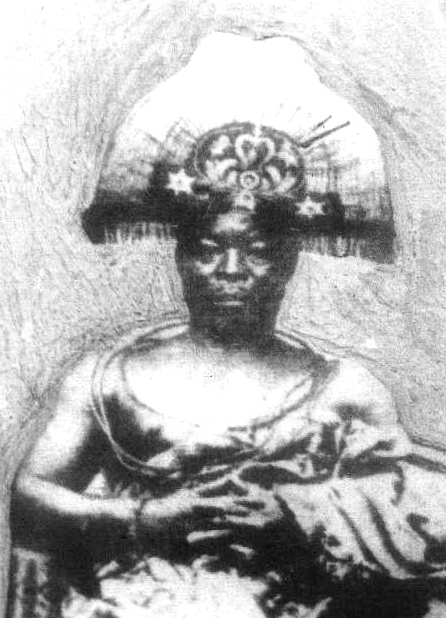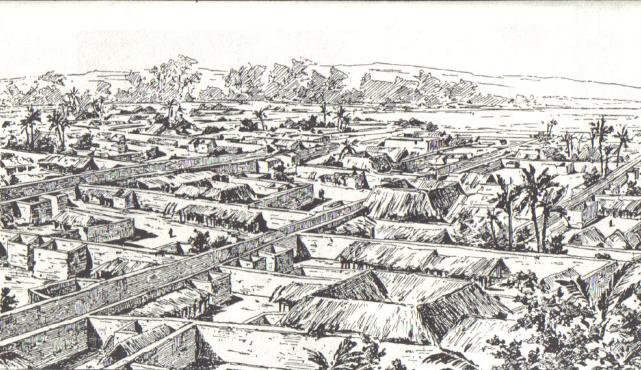|
Obanosa
Obanosa, originally known as Osifo Akengbuda, was the thirty-first Oba of Benin, Oba of the Benin Kingdom, reigning from . His reign was marked by a notable conflict known as the Okpughe. Little is known about Obanosa's early life, including specific details about his birth date and place of birth. However, historical records indicate his royal lineage within the Benin Kingdom, and he ascended to the throne following the passing of his predecessor, Oba Akengbuda. The rivalry between Obanosa and Osopakharha, two charismatic young men in the Benin Kingdom during the early 19th century, was a defining feature of Obanosa's reign as Oba. This intense competition had far-reaching consequences that left a lasting imprint on the History of Benin City, history of Benin. The rivalry played out in the social and political arenas of Benin City, with both men competing for influence and recognition. It culminated in a violent and destructive conflict known as the Okpughe, resulting in the trag ... [...More Info...] [...Related Items...] OR: [Wikipedia] [Google] [Baidu] |
Osemwende
Osemwende (c. 1780–1848), originally known as Prince Eredia-uwa, was the thirty-third Oba of Benin who reigned from . He was the son of Oba Obanosa and the brother of Ogbebo, whom he defeated in a civil war to claim the throne. He restored peace and stability to the kingdom after a turbulent period of succession crisis and expanded and consolidated his empire through military conquests and diplomatic alliances. He also promoted trade and commerce with foreign nations, especially the Portuguese Empire, Portuguese, and fostered art and learning among his people. He was revered as a wise and benevolent ruler who brought good tidings to his kingdom. Background The Kingdom of Benin was a pre-colonial African state located in what is now known as the Southern region of Nigeria. Founded by the Edo people, the kingdom operated under a monarchy system, with the Oba of Benin serving as the supreme ruler. The Oba held significant political and spiritual authority over the populace, als ... [...More Info...] [...Related Items...] OR: [Wikipedia] [Google] [Baidu] |
Akengbuda
Akengbuda (c. 1720 – 1804) was the thirtieth Oba of Benin who reigned from . He was the son and successor of Eresoyen, and the father of Obanosa. He is regarded as one of the most powerful and influential obas in the history of the Kingdom of Benin, as he expanded the kingdom's territory, improved its administration, and promoted its arts and culture. He also maintained a strong trade relationship with the Europeans, especially the Portuguese and the British, and acquired firearms and other goods from them. He was known for his military prowess, his diplomatic skills, and his patronage of arts and learning. Background The Kingdom of Benin was a pre-colonial African state that existed in what is now southern Nigeria. It was founded by the Edo people in the 11th century AD, after they rebelled against their previous rulers, the Ogisos. The first oba of Benin was Eweka I, who was the son of Oranmiyan, a prince from Ife, another powerful West African kingdom. The obas of Benin ... [...More Info...] [...Related Items...] OR: [Wikipedia] [Google] [Baidu] |
Ogbebo
Ogbebo was the thirty-second Oba of Benin, Oba who ruled the Benin Empire in 1816 AD, albeit for a brief period. His time in power was marked by a contest for control of the Benin throne, leading to a civil conflict. Details about Ogbebo's early life are scarce. He was born into the royal lineage of the kingdom as the son of Oba Obanosa. However, his path to the throne was marked by a dispute with his elder brother, Prince Eredia-uwa, over the rightful heir to the Benin throne. This dispute, rooted in differing claims of seniority, led to a struggle for dominance. The rivalry between Ogbebo and Eredia-uwa not only involved the two brothers but also drew in influential chiefs and supporters from within the Benin Kingdom, resulting in a civil conflict with significant political consequences. Ogbebo's mother played a role in supporting his claim to the throne. Oba Ogbebo's rule lasted just eight months, and it faced opposition from those who believed Prince Eredia-uwa was the right ... [...More Info...] [...Related Items...] OR: [Wikipedia] [Google] [Baidu] |
Oba Of Benin
The Oba of Benin is the traditional ruler and the custodian of the culture of the Edo people and all Edoid people. The then Kingdom of Benin (not to be confused with the modern-day and unrelated Republic of Benin, which was then known as Dahomey) has continued to be mostly populated by the Edo (also known as Benin ethnic group). The dynasty is sometimes called the "Eweka dynasty", after its first ruler, Eweka I, and was preceded by the Ogiso monarchy. In 1897, a British military force of approximately 1,200 men under the command of Sir Harry Rawson mounted the Benin punitive Expedition. The force was dispatched in retaliation to the ambush of a British party, at Ugbine village near Gwato on 4 January 1897 by a group of Benin soldiers who were acting without orders from the Oba; the ambush had led to the deaths of all but two of the British party. The British force captured the capital of the Kingdom of Benin, sacking and burning the city while forcing the Oba of Benin, Ov ... [...More Info...] [...Related Items...] OR: [Wikipedia] [Google] [Baidu] |
Benin Kingdom
The Kingdom of Benin, also known as Great Benin, is a traditional kingdom in southern Nigeria. It has no historical relation to the modern republic of Benin, which was known as Dahomey from the 17th century until 1975. The Kingdom of Benin's capital was Edo, now known as Benin City in Edo State, Nigeria. The Benin Kingdom was one of the oldest and most developed State (polity), states in the coastal hinterland of West Africa. It grew out of the previous Edo people, Edo Kingdom of Igodomigodo around the 11th century AD; it was annexed by the British Empire in 1897, but endured as a non-sovereign monarchy. In the 15th and 16th centuries, the kingdom reached the height of its prosperity, expanding its territory, trading with European powers, and creating a remarkable artistic legacy in cast bronze, iron, brass, carved ivory, and other materials. History Early By the 1st century BC, the Benin territory was partially agricultural; and it became primarily agricultural by around A. ... [...More Info...] [...Related Items...] OR: [Wikipedia] [Google] [Baidu] |
History Of Benin City
Benin City serves as the capital and largest metropolitan centre of Edo State, situated in southern Nigeria. It ranks as the fourth-most populous city in Nigeria, according to the 2006 national census, preceded by Lagos, Kano, and Ibadan. Geography Benin City is located in close proximity to the Benin River, situated approximately to the north, whilst its eastern perimeter lies from Lagos via the arterial road network. The city's municipal boundaries converge with those of several prominent neighbouring towns in southern Nigeria, notably Agbor, Oghara, and Ekpoma. Agriculture Benin City boasts an exceptionally fertile agricultural landscape and serves as the epicentre of Nigeria's thriving rubber industry. Additionally, the production of palm oil constitutes a substantial sector, further underscoring the city's prominence in Nigeria's agricultural economy. Trade The city of Benin served as the paramount settlement of the Edo Kingdom of Benin, a pre-colonial po ... [...More Info...] [...Related Items...] OR: [Wikipedia] [Google] [Baidu] |
Benin City
Benin City serves as the Capital city, capital and largest Metropolitan area, metropolitan centre of Edo State, situated in Nigeria, southern Nigeria. It ranks as the List of Nigerian cities by population, fourth-most populous city in Nigeria, according to the Census in Nigeria, 2006 national census, preceded by Lagos, Kano (city), Kano, and Ibadan. Geography Benin City is located in close proximity to the Benin River, situated approximately to the north, whilst its eastern perimeter lies from Lagos via the arterial road network. The city's municipal boundaries converge with those of several prominent neighbouring towns in Nigeria, southern Nigeria, notably Agbor, Oghara, and Ekpoma. Agriculture Benin City boasts an exceptionally fertile agricultural landscape and serves as the epicentre of Nigeria's thriving Natural rubber, rubber industry. Additionally, the production of palm oil constitutes a substantial sector, further underscoring the city's prominence in Nigeria ... [...More Info...] [...Related Items...] OR: [Wikipedia] [Google] [Baidu] |
Uselu, Benin City
Uselu is a densely populated neighborhood of Benin City, Edo State, Nigeria. It is the headquarters of Egor local government area. Uselu is the site of the traditional grounds of the Edaiken N'Uselu (Duke of Uselu) palace as well as the palace of the Iyoba of Benin. History When King Ozolua died in the fifteenth century, he left behind two sons to dispute the royal succession: Esigie controlled Benin City, the kingdom's metropolitan center, while his brother Arhuaran was based in Udo – an important provincial seat 20 miles away. Neither prince was prepared to yield to the other, partisans soon declared for one or the other, and Benin was plunged into a civil war shortly thereafter. Seeing an opportunity to take advantage of the situation, the hitherto vassal Igala people declared their independence from Benin and seized a swath of territory to its north. In the span of a week, Esigie found himself confronted with what now seemed like the almost certain fragmentation of his f ... [...More Info...] [...Related Items...] OR: [Wikipedia] [Google] [Baidu] |
Kingdom Of Benin
The Kingdom of Benin, also known as Great Benin, is a traditional kingdom in southern Nigeria. It has no historical relation to the modern republic of Benin, which was known as Dahomey from the 17th century until 1975. The Kingdom of Benin's capital was Edo, now known as Benin City in Edo State, Nigeria. The Benin Kingdom was one of the oldest and most developed State (polity), states in the coastal hinterland of West Africa. It grew out of the previous Edo people, Edo Kingdom of Igodomigodo around the 11th century AD; it was annexed by the British Empire in 1897, but endured as a non-sovereign monarchy. In the 15th and 16th centuries, the kingdom reached the height of its prosperity, expanding its territory, trading with European powers, and creating a remarkable artistic legacy in cast bronze, iron, brass, carved ivory, and other materials. History Early By the 1st century BC, the Benin territory was partially agricultural; and it became primarily agricultural by around A. ... [...More Info...] [...Related Items...] OR: [Wikipedia] [Google] [Baidu] |
1816 Deaths
This year was known as the '' Year Without a Summer'', because of low temperatures in the Northern Hemisphere, possibly the result of the 1815 eruption of Mount Tambora in Indonesia, causing severe global cooling, catastrophic in some locations. Events January–March * January 6 – (December 25, 1815 on the Russian Julian calendar): Tsar Alexander I of Russia signs an order, expelling the Jesuits from St. Petersburg and Moscow. * January 9 – **Sir Humphry Davy's Davy lamp is first tested underground as a coal mining safety lamp, at Hebburn Colliery in northeast England; **Ludwig van Beethoven wins the custody battle for his nephew Karl. * January 17 – Fire nearly destroys the city of St. John's, Newfoundland. * February 10 – Friedrich Karl Ludwig, Duke of Schleswig-Holstein-Sonderburg-Beck, dies and is succeeded by Friedrich Wilhelm, his son and founder of the House of Glücksburg. * February 20 – Gioachino Rossini's opera buffa ''The Barber of Sevi ... [...More Info...] [...Related Items...] OR: [Wikipedia] [Google] [Baidu] |




